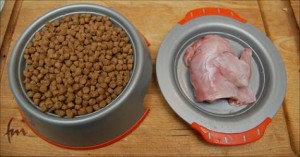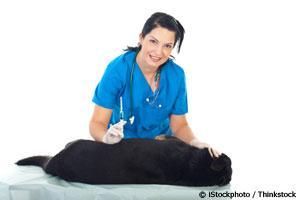The American Animal Hospital Association (AAHA) Canine Vaccination Task Force has updated their vaccination guidelines for 2011.
According to AAHAnet.org:
Developed in a manner consistent with best vaccination practices, the 2011 Guidelines include expert opinions supported by scientific study, published and unpublished documents, and encompass all canine vaccines currently licensed in the U.S. and Canada. The task force that developed the guidelines included experts in immunology, infectious diseases, internal medicine, law, and clinical practice.
I’m encouraged by, if not blissful about the new guidelines.
The absolute highlight is that all core vaccines with the exception of the 1-year rabies are now recommended at 3-year or greater intervals.
Even more exciting is the task force has acknowledged that in the case of the non-rabies core vaccines, immunity lasts at least 5 years for distemper and parvo, and at least 7 years for adenovirus.
Hopefully these new guidelines will help more dog owners understand the long-lasting effect of those puppy shots! And hopefully, more dog owners will now request titers rather than automatically revaccinating their canine companions for distemper, parvo and adenovirus.
Please note: My vaccine recommendations and those of Dr. Ronald Schultz, follow this summary.
CORE VACCINES
Canine Distemper (CDV)
Initial vaccination in puppies < 16 weeks of age
- Starting at 6 weeks, vaccinate every 3 to 4 weeks (6, 10, 14 or 8, 12, 16 weeks) up to 14 or 16 weeks; final shot should be given between 14 and 16 weeks to minimize risk of maternal antibody interference
Initial vaccination in dogs > 16 weeks of age
Revaccination
- For puppies who received initial vaccination series by 16 weeks, a booster no later than 1 year after completion of initial series, then ≥ 3 years thereafter
- For dogs who received initial vaccination after 16 weeks of age, every ≥ 3 years thereafter
Notes: Among healthy dogs, distemper vaccines are expected to induce immunity for at least 5 years.
Canine Parvo (CPV-2)
Initial vaccination in puppies < 16 weeks of age
- Starting at 6 weeks, vaccinate every 3 to 4 weeks (6, 10, 14 or 8, 12, 16 weeks) up to 14 or 16 weeks; final shot should be given between 14 and 16 weeks to minimize risk of maternal antibody interference
Initial vaccination in dogs > 16 weeks of age
Revaccination
- For puppies who received initial vaccination series by 16 weeks, a booster no later than 1 year after completion of initial series, then ≥ 3 years thereafter
- For dogs who received initial vaccination after 16 weeks of age, every ≥ 3 years thereafter
Notes: Among healthy dogs, distemper vaccines are expected to induce immunity for at least 5 years.
Canine Adenovirus (CAV-2)
Initial vaccination in puppies < 16 weeks of age
- Starting at 6 weeks, vaccinate every 3 to 4 weeks (6, 10, 14 or 8, 12, 16 weeks) up to 14 or 16 weeks; final shot should be given between 14 and 16 weeks to minimize risk of maternal antibody interference
Initial vaccination in dogs > 16 weeks of age
Revaccination
- For puppies who received initial vaccination series by 16 weeks, a booster no later than 1 year after completion of initial series, then ≥ 3 years thereafter
- For dogs who received initial vaccination after 16 weeks of age, every ≥ 3 years thereafter
Notes: Among healthy dogs, distemper vaccines are expected to induce immunity for at least 7 years.
Rabies 1-year
Initial vaccination in puppies < 16 weeks of age
- One dose not earlier than 12 weeks or as required by law
Initial vaccination in dogs > 16 weeks of age
Revaccination
- For all dogs: annually as required by law
Rabies 3-year
Initial vaccination in puppies < 16 weeks of age
- One dose not earlier than 12 weeks or as required by law
Initial vaccination in dogs > 16 weeks of age
Revaccination
- For all dogs: within 1 year of initial dose regardless of age at time of initial dose, then every 3 years thereafter as required by law
NON-CORE VACCINES
Measles Vaccine (MV)
This vaccine is supposed to provide temporary immunization of young puppies against distemper by ‘cross-protecting’ them against the disease in the event there are still maternally derived antibodies present. It is always given in combination with other vaccines — distemper plus measles, or a 4-way combination of distemper plus measles plus adenovirus plus parainfluenza.
It is only recommended for healthy dogs between 6 and 12 weeks of age.
Canine Parainfluenza (CPiV)
There are two delivery systems for this vaccine — intranasal and parenteral (injected).
This is a flu vaccine. The intranasal form prevents clinical signs of illness, infection and shedding. The injected form prevents clinical illness, but not infection or shedding. It is used for dogs that aggressively resist intranasal delivery.
The parenteral vaccine is always given in combination with certain core vaccines; the intranasal form is always given in combination with the bordetella vaccine alone, or with bordetella plus adenovirus.
It is always given in a single dose. Revaccination recommendations, depending on the form of the vaccine (intranasal or parenteral), are per the combined core vaccine schedule, annually, or more frequently for ‘high risk’ animals.
Bordetella (Bb) Vaccine
The bordetella vaccine can also be delivered intranasally or by injection.
Parenteral administration requires two doses, 2 to 4 weeks apart. For the initial vaccination, it is recommended the second dose be given at least a week before the dog is boarded, attends a dog show, etc. Revaccination is recommended annually
The intranasal vaccine is single dose, with revaccination recommended annually or more often for ‘high risk’ dogs. Some dogs experience side effects for 3 to 10 days after vaccination, including coughing, sneezing and nasal discharge.
Canine Adenovirus (CAV-2) — Intranasal
The intranasal form of the adenovirus vaccine is a non-core vaccine.
It’s recommended for dogs at risk for respiratory infection caused by the adenovirus, and it may not provide immunity against canine hepatitis. It should not be considered a replacement for the injectable form of the vaccine.
This vaccine is available only in combination with the intranasal bordetella and parainfluenza vaccines.
Canine Influenza
Vaccine is given in two doses, 2 to 4 weeks apart, in dogs older than 6 weeks. Annual revaccination is recommended.
Borrelia burgdorferi (Lyme disease)
Vaccine is given in two doses, 2 to 4 weeks apart, in dogs older than 12 weeks of age. Revaccination is recommended annually and/or at the beginning of tick season as determined regionally.
Notes: Recommended only for use in dogs with known risk of exposure, living in or visiting regions where exposure risk is high or where Lyme disease is endemic. Tick control products are required in addition to the vaccine.
Leptospira interrogans
This refers to the 4-way killed whole cell or subunit bacterin. The 2-way killed bacterin form of this vaccine is not recommended.
Vaccine is given in two doses, 2 to 4 weeks apart, in dogs older than 12 weeks of age. Revaccination is recommended annually, but only for dogs with reasonable risk of exposure.
Notes: Vaccination should be based on known geographic occurrence/prevalence and exposure risk of the individual dog.
Canine Oral Melanoma
This vaccine is only available for treatment of dogs with malignant melanoma. It is not intended for the prevention of oral melanoma.
Crotalus atrox (Western Diamondback rattlesnake vaccine) (toxoid)
Field efficacy and experimental challenge data in dogs are not available at this time. (Vaccine efficacy and dose recommendations are based on toxin neutralization studies conducted in mice.)
Canine Coronavirus (CCov)
This vaccine is not recommended. Neither the modified live nor the killed CCov vaccine has proved effective against combination coronavirus/parvo disease. Only the parvo vaccine is protective against dual viruses.
For those of you not familiar with Dr. Schultz, I recommend you watch my 4-part video series with him. You can find links to all 4 videos and articles here.
Dr. Schultz is one of the preeminent experts in the field of veterinary vaccines. If you read the full AAHA vaccination guidelines report, you’ll see his work referenced throughout.
Dr. Schultz recommends not starting a puppy or kitten core vaccination program before 6 to 8 weeks of age, with revaccinations no more frequent than every 4 weeks. So for example, if you start the program at 8 weeks, you would give another dose of the core vaccines at 12 weeks, and the third dose at 16 weeks.
Dr. Schultz’s core vaccine protocol for his own family’s pets differs in that he actually runs antibody titers on the mother to know exactly when the best time is to effectively immunize the puppy or kitten for the 3 core viruses. Then he titers the little ones 2 or more weeks after the vaccine, and as long as the response is adequate, he doesn’t in most cases revaccinate for the rest of the pet’s life.
When it comes to rabies vaccines, Dr. Schultz gives the first vaccine after 4 months of age, revaccinates in a year, and then again in 3 years and every 3 years thereafter. In other words, he follows the law for 3-year rabies vaccines, even though he doesn’t believe a vaccination every 3 years is necessary for immunization.
Currently Dr. Schultz is in year 4 of a 7-year study of the rabies vaccine. You can read more about the study at the Rabies Challenge Fund. His goal is to be able to recommend that after an animal is vaccinated at from 12 to 24 weeks for rabies, there’s no need for re-vaccination every 3 years.
Hopefully we’ll see the results of his 7-year study reflected in a future revision of the AAHA’s canine vaccination guidelines, as well as in state and local laws.
My protocol at Natural Pet is a first round of the 3 cores before 12 weeks of age, usually around 9 to 10 weeks. Then I boost between 15 and 16 weeks. Then I titer 2 weeks after the second round to see if the animal has been immunized and not just vaccinated.
My rabies protocol mirrors Dr. Schultz’s, except I prefer to wait until 6 months of age before giving rabies vaccine.
As for the non-core vaccines, I don’t recommend any of them. Visit the following pages for a discussion of:
Note several non-core vaccines are only available in combination with other vaccines, some of which are core. I recommend you check with your vet to ensure none of the non-core vaccines are being piggy-backed on core vaccines your pet receives. Most traditional vets do not carry single vaccines, so ask to see the vaccine vial before assuming your pet is only receiving one agent at a time.




 dolphin that she can touch that ball on purpose to make that trainer give her another fish. Now that the intent is clear that the behavior is to touch the ball with her nose, the trainer can introduce a hand signal or word right before she touches it, which becomes the command. The trainer might suspend the ball from a rope right at water level, and ask for and whistle/reward touches to the ball. Then the ball can be raised a little at a time and the dolphin must now stretch to reach it, and then jump to reach it, etc. Targeting can also be used to teach her to touch other parts of her body to objects or even a trainer’s hand, allowing the trainer to perhaps shake a flipper (first a “trick”) and then this trick is used to slowly shape a far more difficult behavior, like allowing a vet to take blood from a vein on that flipper – all with voluntary participation from that dolphin. It removes the fear of that procedure as it’s taught gradually, and is certainly easier and much less risky for everyone involved than corralling that dolphin and herding her into some sort of restraint device that would enable them to get that blood sample forcefully, and good luck getting that done a second time! With positive reinforcement training, it became possible for trainers to get voluntary participation from the dolphins for complex behaviors like veterinary procedures, helping to greatly lower the stress for the dolphins if they needed care.
dolphin that she can touch that ball on purpose to make that trainer give her another fish. Now that the intent is clear that the behavior is to touch the ball with her nose, the trainer can introduce a hand signal or word right before she touches it, which becomes the command. The trainer might suspend the ball from a rope right at water level, and ask for and whistle/reward touches to the ball. Then the ball can be raised a little at a time and the dolphin must now stretch to reach it, and then jump to reach it, etc. Targeting can also be used to teach her to touch other parts of her body to objects or even a trainer’s hand, allowing the trainer to perhaps shake a flipper (first a “trick”) and then this trick is used to slowly shape a far more difficult behavior, like allowing a vet to take blood from a vein on that flipper – all with voluntary participation from that dolphin. It removes the fear of that procedure as it’s taught gradually, and is certainly easier and much less risky for everyone involved than corralling that dolphin and herding her into some sort of restraint device that would enable them to get that blood sample forcefully, and good luck getting that done a second time! With positive reinforcement training, it became possible for trainers to get voluntary participation from the dolphins for complex behaviors like veterinary procedures, helping to greatly lower the stress for the dolphins if they needed care.

